Home
Euphorbia trigona
Although not a true cactus, the attractive African milkweed looks tall and has thin, cactus-like spines and small leaves. In fact, this plant is a fast-growing succulent that is very easy to propagate by cuttings and is undemanding.
This type of succulent feels great in partial shade, but flowering of this species is difficult to achieve indoors. Similar to succulents with leaves is Pereskia.
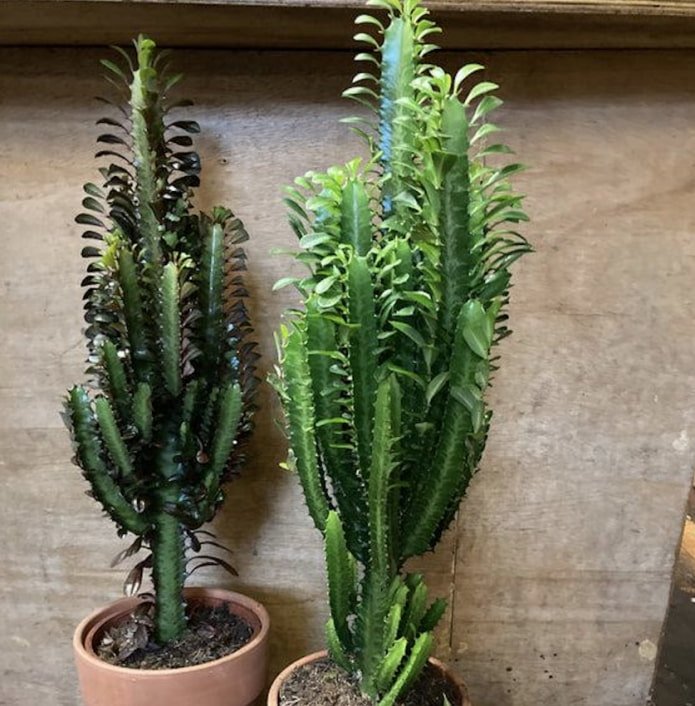
Echinopsis or Ferocactus
Barrel cacti are a wide range of squat, rounded, spiny varieties of Echinocactus from the genera Echinocactus and Ferrocactus. These pretty, spherical specimens come with thin spines of different colors – for example, the golden globe cactus has bright yellow spines.
Provide them with plenty of warmth and bright sunlight, and over time they will bloom with white, red or yellow flowers.
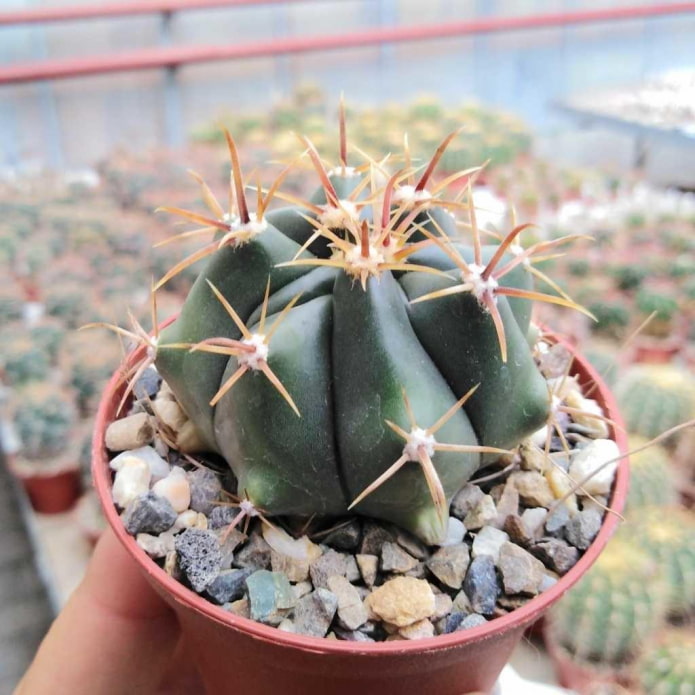
Gymnocalycium baldianum
Also called spider cactus, this low-growing, round species with a weak root system is native to Argentina. With a squat, slightly flattened, rounded stem, it is less spiny than other varieties and is primarily known for its vibrant flowers, which come in shades of white, yellow, red (as pictured), pink, purple, or orange, and are usually located at the top of the plant.
This member of the Cactaceae family is a bit different from others on this list in that it needs protection from direct sunlight and prefers a little extra moisture – water it every two weeks or whenever the top inch of soil feels dry.
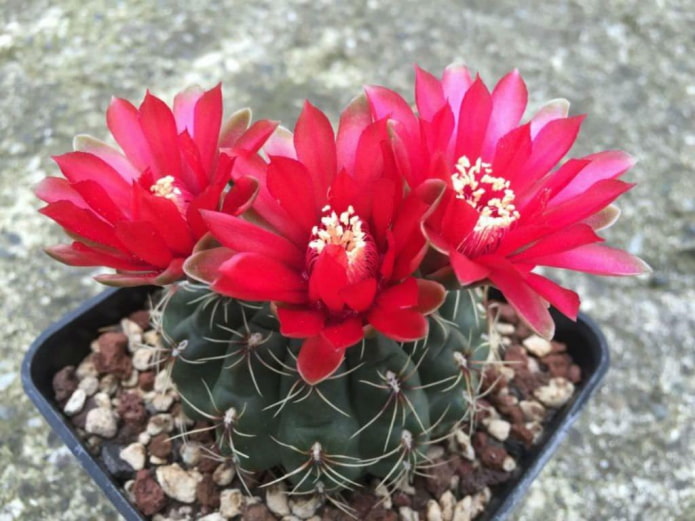
Mammillaria elongata
Nature – Mexico. This prickly cactus gets its common name from its long, finger-like appendages. The flowering cactus is covered in flowers in shades of yellow and white.
Like other cacti, plant it in a grainy, well-draining soil mix and water it sparingly every few weeks after the soil has dried out completely to avoid root rot. Since the shoots of Mammillaria are very prickly, when transplanting or propagating, be sure to use tweezers or special gloves to protect your hands.
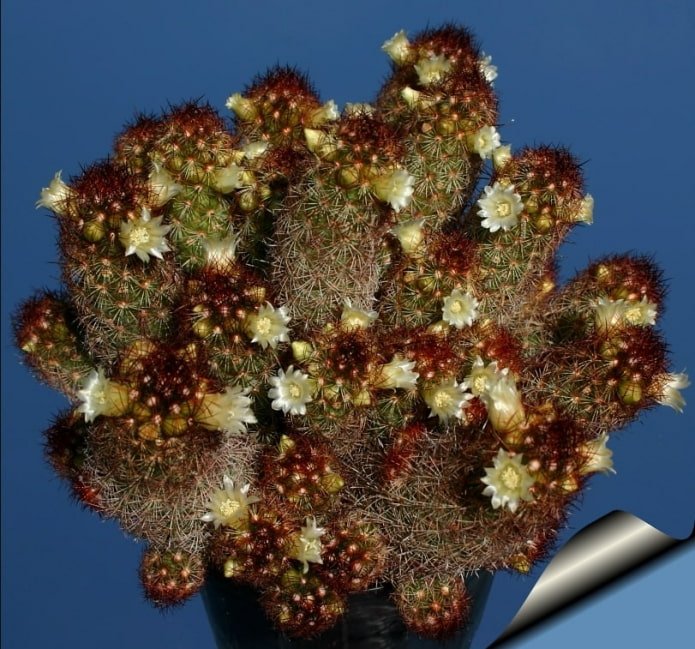
Schlumbergera or Decembrist (Schlumbergera)
Schlumbergera is native to the jungles of Brazil, so caring for it is a little different from many other specimens. Keep the soil slightly moist during the spring and summer growing season, allowing it to dry out slightly between waterings in the winter.
Although the plant prefers warmer temperatures during the growing season, keep it in a cool location with at least 13 hours of darkness per day once the plant produces buds, as pictured above. If disturbed, the blooming Christmas cactus may drop all of its flowers. Usually flowering begins in winter.

Desert
Carnegiea gigantea
This is the iconic cactus that we imagine when we imagine desert landscapes and arid conditions. It has powerful fleshy shoots and not very long thin spines. With proper care, you can enjoy them for years to come.
Water the plant sparingly – once a month, allowing the soil to dry out completely between waterings, and provide it with plenty of bright, direct sunlight.

Opuntia
The same flat-headed, blade-shaped cacti that produce colorful edible fruits when grown outdoors can also thrive as houseplants under the right conditions. Flowering specimens have vibrant yellow and orange buds. The shoots have short spines that do not always develop.
Place them in a brightly lit window on the south or west side so that they can soak up as much direct sunlight as possible – without sufficient lighting, cacti grow long and skinny, rather than wide and full, as this variety is most common in desert conditions.
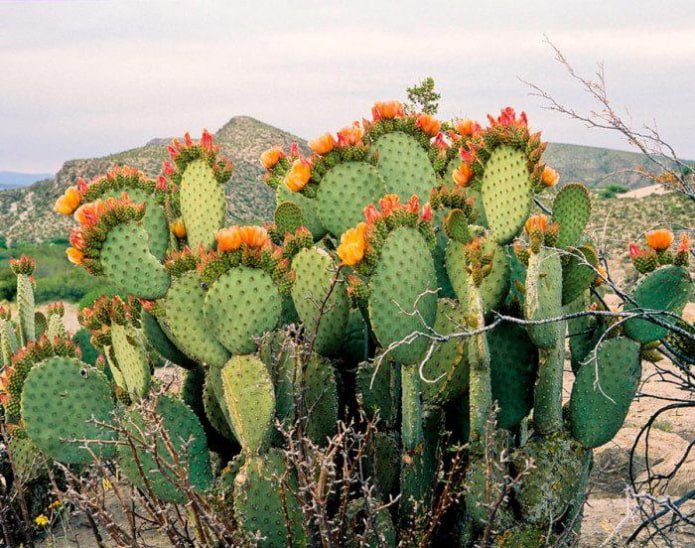
Candelabra Cactus (Myrtillocactus cochal)
A taller version of succulents with long, sharp spines that prefer desert conditions. Shoots reach 3 meters in height, but it is not very frost-resistant. It grows well in a pot, and in summer it can be placed outdoors as a summer garden decoration. The white flowers of the cactus are a nice bonus.
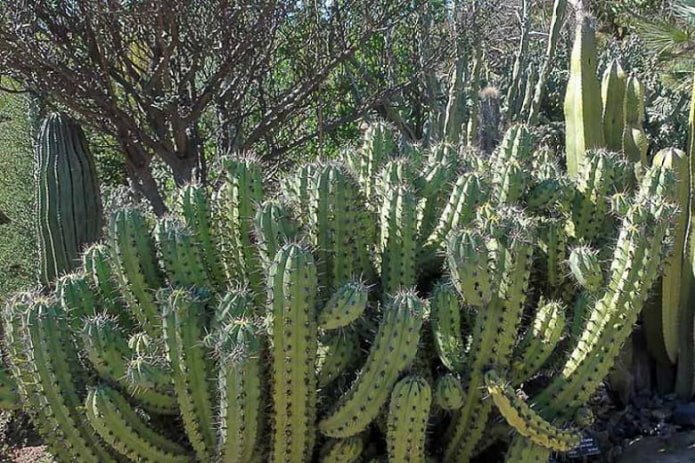
Columnar Cactus (Pilosocereus royenii)
It reaches 3.5 meters in height. This is a variant of a succulent with a columnar shoot. In colder areas, grow it in a container and use it as an additional decoration outdoors in summer.

Lemaireocereus thurberi
The Lemaireocereus cactus, a member of the Cereus genus, has stems that resemble old-fashioned organ pipes. These tall, columnar plants branch slightly above the ground into several ribbed stems. Native to the desert regions of Sanora in North America, these plants require sun and minimum winter temperatures above 35 degrees Fahrenheit.
The cactus can reach 30 feet (9 meters) in height and the same width, although they are usually smaller in most gardens. Its white flowers open in the evening and close at dawn in spring. The cactus makes an attractive addition to a patio garden or can be used in raised planters or as a hedge.
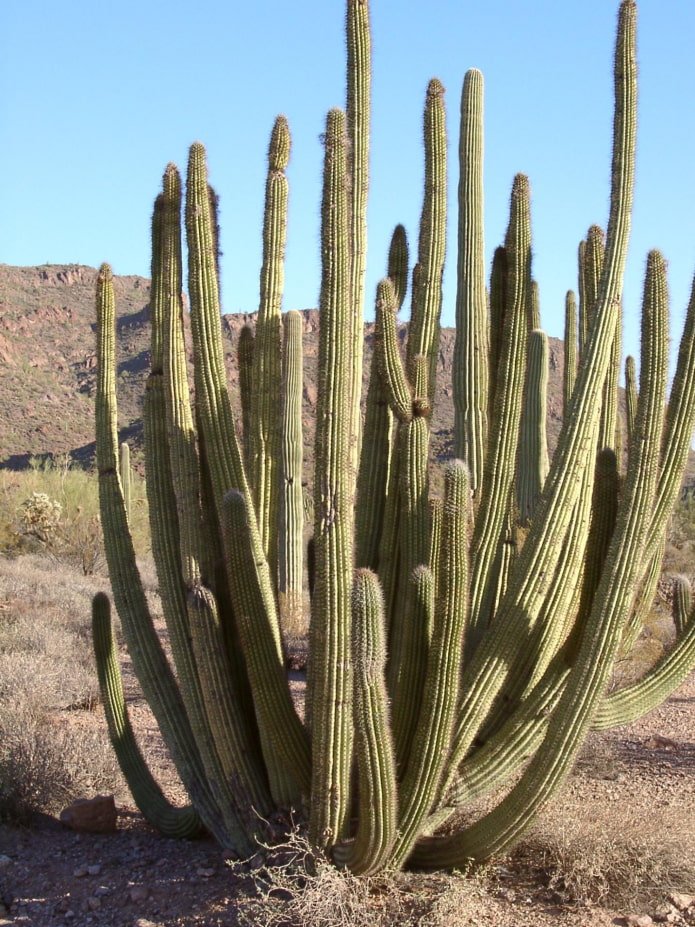
Tropical
Totem Pole Cactus
The Totem Pole Cactus (Pachycereus schottii monstrosus) is a species of columnar cactus native to Mexico and belongs to the genus Cereus. It is easily recognized by its long, bumpy, fleshy, hairless green stems that grow up to 3.5 meters (12 ft) tall. The plant gets its common name from its resemblance to a totem pole.
This tall cactus is not for the faint of heart. At first glance, it looks quite bizarre. The entire body of this tall cactus is completely bare. No spines, no areoles that can be seen from afar. It is a solid wall of green that reaches towards the sky. At the top, the stem curves outward into medium-sized tubercles (these are the areoles). These tubercles look like carved faces, like those you might see on a Red Indian totem pole. This plant requires full sun and well-drained soil to thrive.
If you live in an area with hot summers, this is the plant for you. Additionally, this plant is relatively drought-tolerant and easy to grow once established, so you won’t have to water it much. Keep in mind that this cactus can get quite heavy, so make sure you have a sturdy support system before planting.
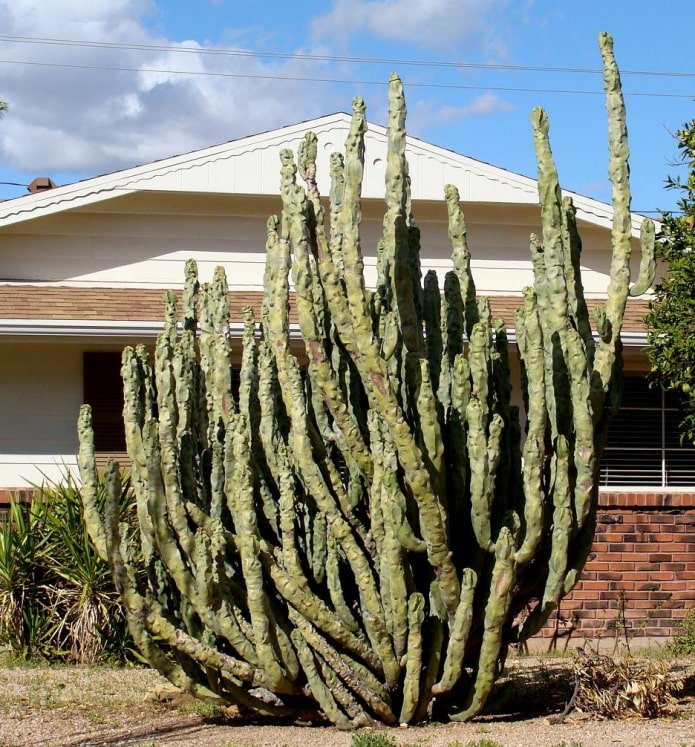
Cephalocereus senilis
Cephalocereus senilis is one of the most popular tropical varieties of cacti in the genus Cereus and can be identified by its tall, columnar or branched growth habit, often covered in long, woolly hairs. The species are easily propagated by seeds, cuttings, or pups. Some collectors wash the “hair” of this species to preserve its whiteness.
The cactus can reach a height of about 12 meters, and its side stems, which bloom at night in mid-spring with large white flowers, are shorter. The size of the plant reaches 6 meters or more. In drought-resistant gardens, the plant looks good in clusters or planted on either side of the entrance. Also similar in appearance to this cactus is espostoa. It has about the same conditions of maintenance.
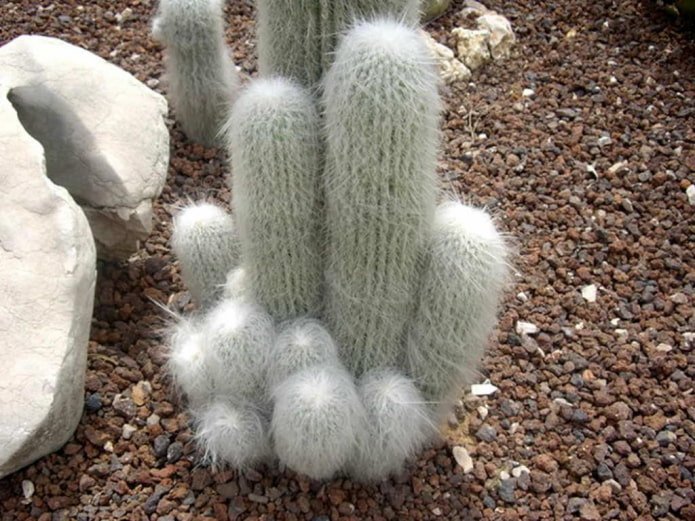
Disocactus flagelliformis
Disocactus flagelliformis, also known as the forest cactus, (Aporocactus flagelliformis or Disocactus flagelliformis) usually grows from 90 to 150 cm in length. It blooms in the spring, producing beautiful red, large tubular flowers, as pictured above. It is distinguished by its fragile shoots. It is best grown as a hanging plant, and likes partial shade.
Consider placing the woodland cactus on a porch, covered patio, or on a tree branch. In cold climates, the woodland cactus is easy to maintain as a houseplant, moving it indoors during the cold season. Similar plants include aporocactus and epiphyllum. During the period of abundant flowering, the surface of the forest cactus is covered with pink flowers that bloom for a month.
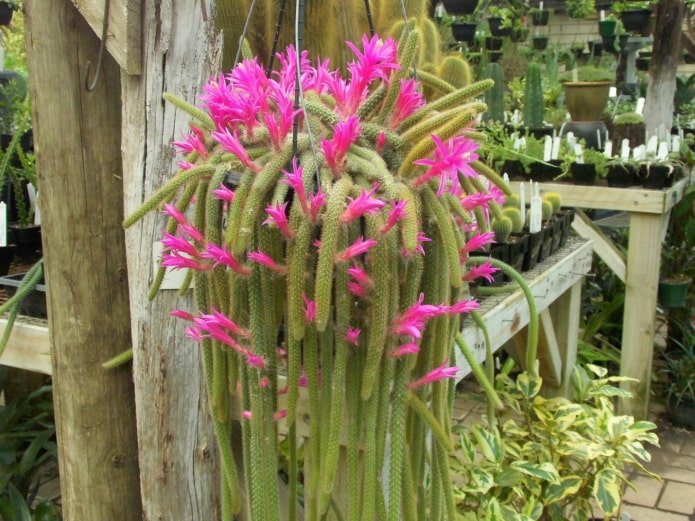
The Most Unusual Species
Myrtillocactus geometrizans cristata
This is an interesting plant native to northern and central Mexico. It can be enormous in size, growing up to 5 meters in height. Although they can become very massive, in their youth they provide a beautiful aesthetic indoors.
The plant is distinguished by the fact that it is a unique species that arises from the intertwined stem of the tree, usually forming ribbed clusters. The plant has a bluish tint and its stem is covered with stiff, sharp spines. These semi-rigid cacti have a waxy body and can be damaged by temperatures below 3 degrees Celsius.
The plant does not need a lot of water. Keep the cactus in bright direct sunlight or filtered sun. This cactus produces white and cream flowers and small fruits in the spring or summer.
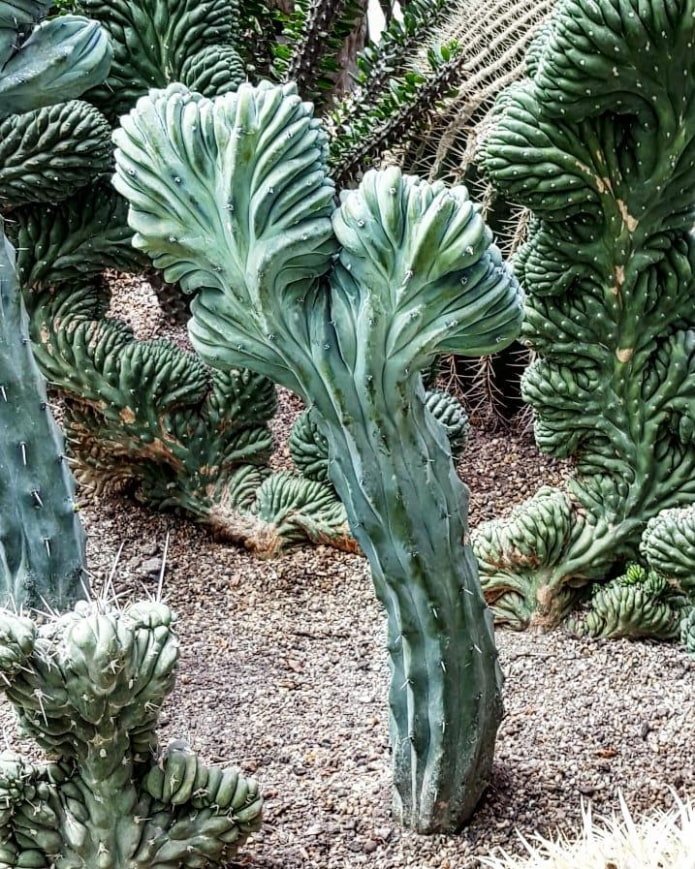
Myrtillocactus geometrizans
It grows up to 4.5 meters tall and up to 3 meters wide. The comb form is usually smaller. In its natural habitat, the blue plant forms dense cactus-like bushes. The cultivar is best known for its upright candelabra-like form, blue-green color, and purple fruits that resemble a cross between blueberries and cranberries in appearance and taste.
Like many other assemblages, Myrtillocactus looks stunning in a container with gravel and rocks. If you live in an area where you can grow it in the ground, this cactus can be the centerpiece of a drought-tolerant cactus or succulent garden, as it is tolerant of dry conditions.

Gymnocalycium mihanovichii
This is a bright and showy variety of moon cactus. It combines beautifully with contrasting dark planters. Although they are usually red, they can be different shades such as purple, white, yellow or even orange. The stem is spherical, colored, with stiff ribs that divide it into several segments. The ribs have white markings on which are located brown spines that grow up to 1 cm in length.
Growing Gymnocalycium is quite simple. When growing, keep in mind that they prefer partial shade, but do not mind spending a few hours in bright direct sunlight. It is best to keep them out of direct sunlight, as this can damage the delicate flowers. Use a store-bought cactus soil mix with good drainage. Don’t overwater the plants, as they are desert-hardy and can survive for long periods without moisture.
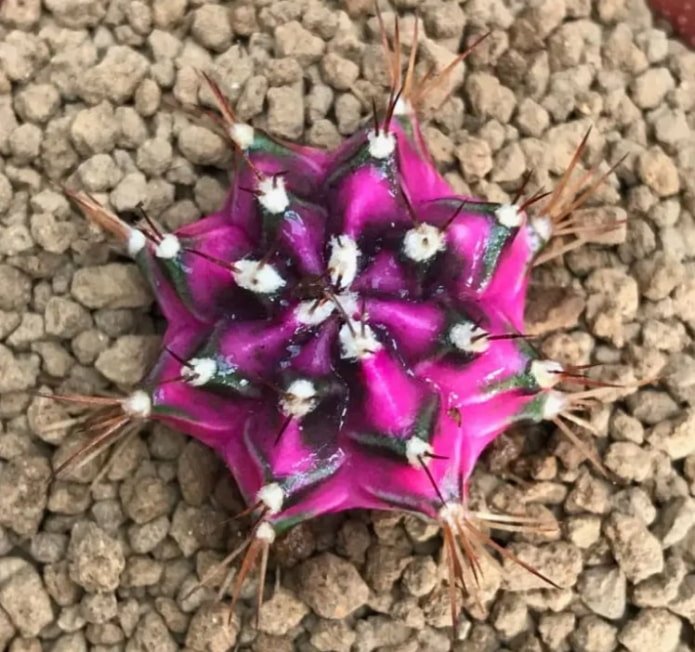
Stenocereus Hollianus Cristata
This prickly variety of exotic cactus is easy to care for and can be used as both a houseplant and a garden plant. Compact and wavy in appearance, it can survive anywhere from full sun to partial shade.
The roots, which can be white or cinnamon-brown, minimize moisture loss, making it a true plant camel. Water the plant thoroughly and allow the soil to dry out completely between waterings. It prefers a well-draining succulent mix.
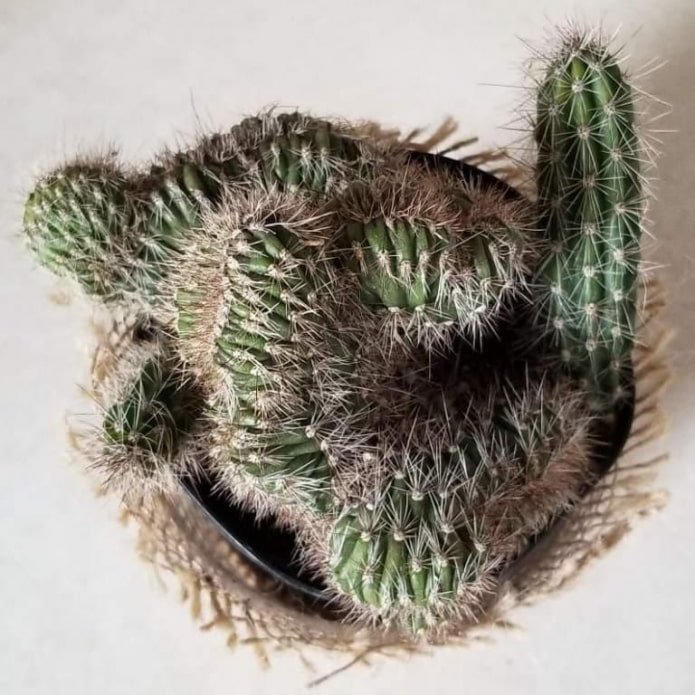
Echinocereus rigidissimus
The pink and beautiful Echinocereus rigidissimus rubrispinus is a showy member of the Cactaceae family that grows in full sun. This variety is spherical in shape and densely covered with small pink spines, as the photo above clearly demonstrates. Although this species is fairly cold hardy, it does not tolerate frost well and may scar.
Use well-draining soil, especially those enriched with perlite. This plant does not need much watering in winter and in high humidity. It produces brilliant pink buds with a white shadow in the center, and looks like a miracle of nature. If you want a beautiful cactus without flowers, this is definitely the one.
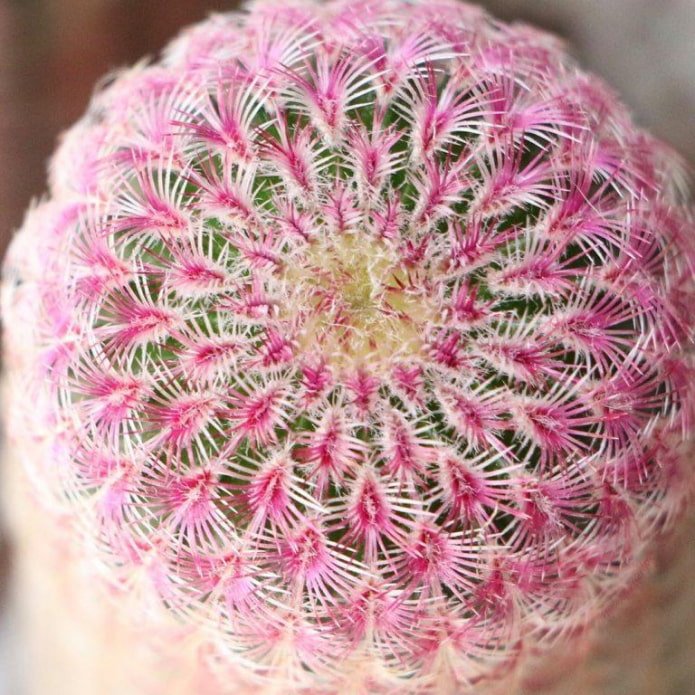
Spineless Cacti
Astrophytum asterias
This is a species that grows to about 5 centimeters in height and 10 centimeters in diameter. There are no spines on the surface of the stem, but the plant has flowers that bloom in late spring or early summer. They are yellow and reach 6.5 centimeters in diameter.
Depending on the variety, cultivar and growing conditions, it can have a lighter or darker green body, and / or with or without white dots. These small dots or spots vary in size and distribution. In any case, this is a cactus that needs to be placed in a sunny spot and with light, well-drained soil. It can withstand light frosts down to -2 degrees Celsius.
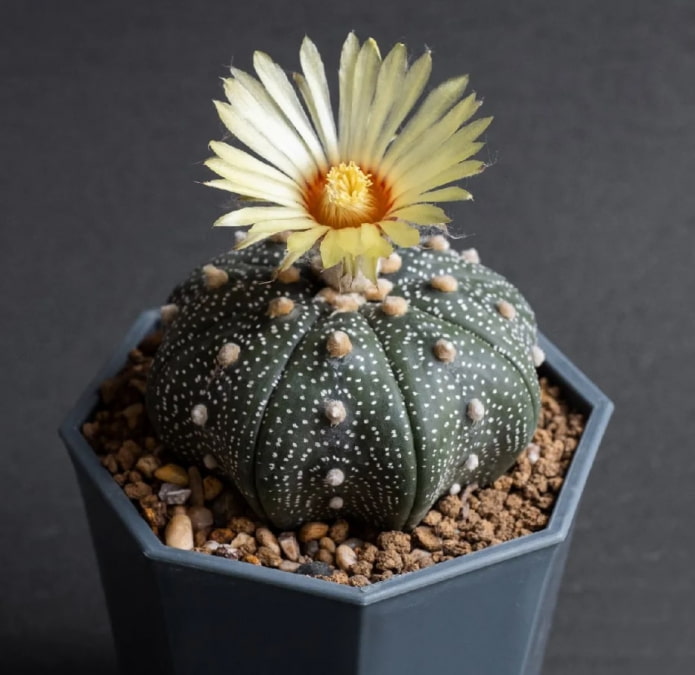
Astrophytum myriostigma
This Mexican native gets its common name from its squat, star-shaped stem, which resembles a uniquely shaped bishop’s cap. Although this cactus has no conspicuous spines, it does, under favorable conditions, produce a long bloom period with a crown of large, colorful flowers at the top. The buds of a blooming Astrophytum are a real decoration for a windowsill.
Young specimens do not tolerate bright light, so keep them in bright, indirect or shaded light until they mature. Since these plants prefer poor, rocky soil, they do not need fertilizing.
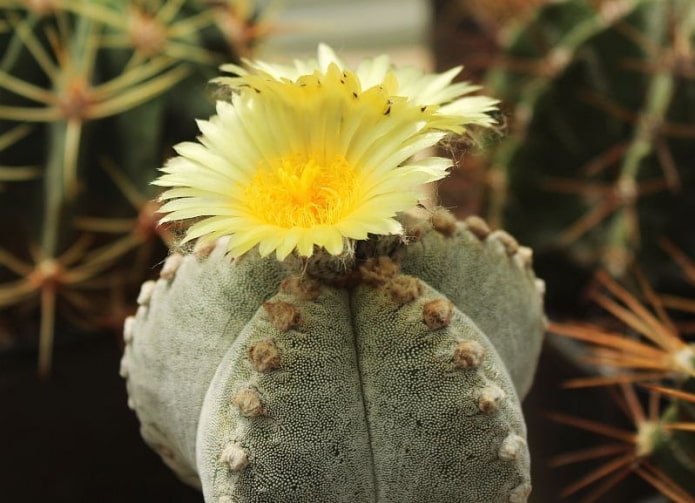
Echinopsis subdenudata
Notocactus is found in Bolivia and Paraguay. When mature, it reaches a maximum of 5 to 8 cm in height and 12 cm in diameter. It has a spherical shape with a greenish-gray stem and 8-12 sharp ribs. This needle-less ball has white and small areoles.
The cactus begins to bloom in the spring, in the form of creamy-white funnel-shaped flowers that adorn the top of the flower. They open only at night and exude a delicate aroma. Flowering plants exude a delicate aroma.
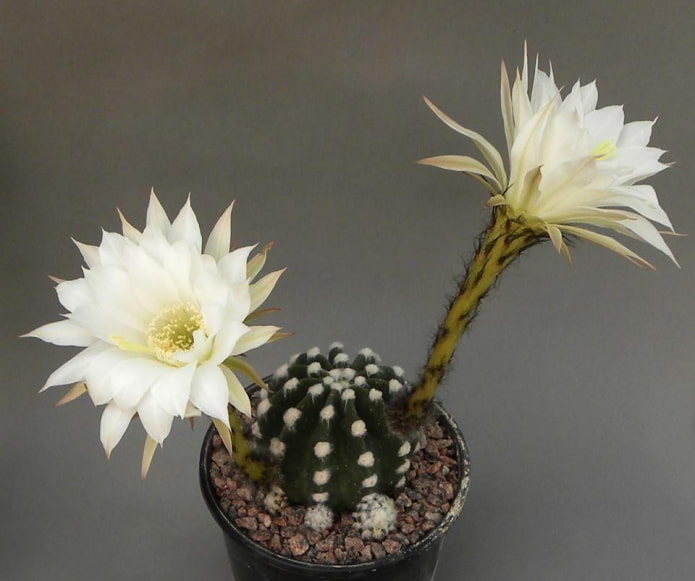
Epiphyllum Oxypetalum
This is a type of epiphytic cactus without needles, which is distinguished by the fact that it develops thickened stems of green color. They can reach a length of about 1 m, and large white flowers emerge from their areoles. The diameter of the plant’s buds reaches 25 centimeters, so they are among the largest among the entire Cactaceae family.
In addition, the blossoming flowers are very fragrant, and they open at dusk in spring and summer. The plant grows quickly and feels good both in a pot and in open ground. Keep in mind that it needs light. It can be in a sunny place or in partial shade. Does not tolerate frost.
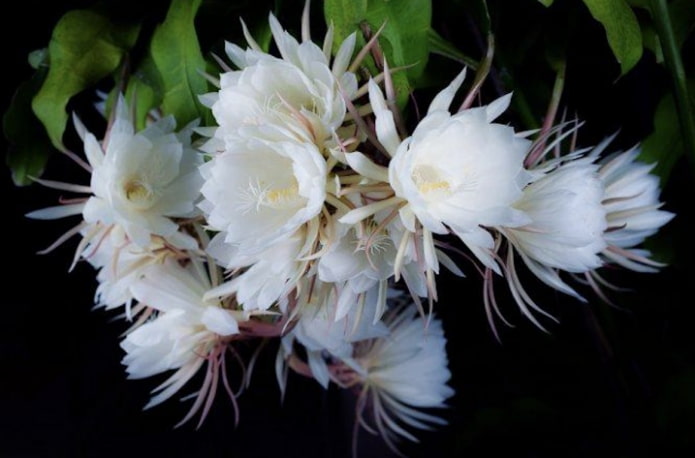
Rhipsalis or Hatiora (Rhipsalis baccifera)
This is the most unusual form of hanging cactus, which develops cylindrical green stems without thorns or needles (as in the photo) up to 1 meter long, similar to leaves. For this reason, rhipsalis is widely used as a hanging plant, either in a pot suspended from the ceiling or on a balcony.
In warm weather, the plant grows quite quickly and blooms in the spring. It differs from other species in that it needs to be planted in partial shade. Of course, if the temperature drops below 0 degrees, it should be placed in room conditions. This flower is often classified as a succulent.
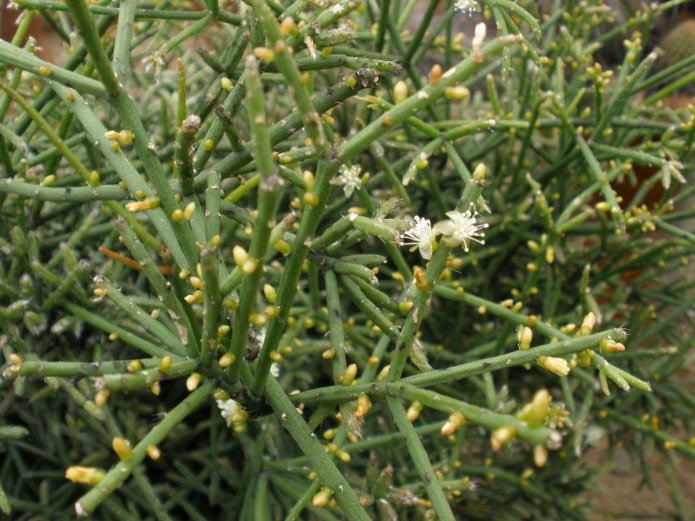
The variety of cacti is amazing: from a simple ball with thorns to a real work of art. You can choose whimsical specimens that require careful care to please the gardener with lovely flowering, or you can choose a species that is extremely easy to grow at home, having read the description of each specimen, or you can stop at a succulent. It all depends on the preferences of the gardener.
Now reading:
- Valuable Furniture Arrangement Tips That Matter.
- Discover the Versatility of the Ford Transit Van
- Folding table: more than 60 photos of modern ideas for the living room, kitchen and children’s room.
- Affordable Products from Fix Price for Garden and Vegetable Garden Decor
- Explore the Fiat Freemont: Stylish Versatility Awaits!